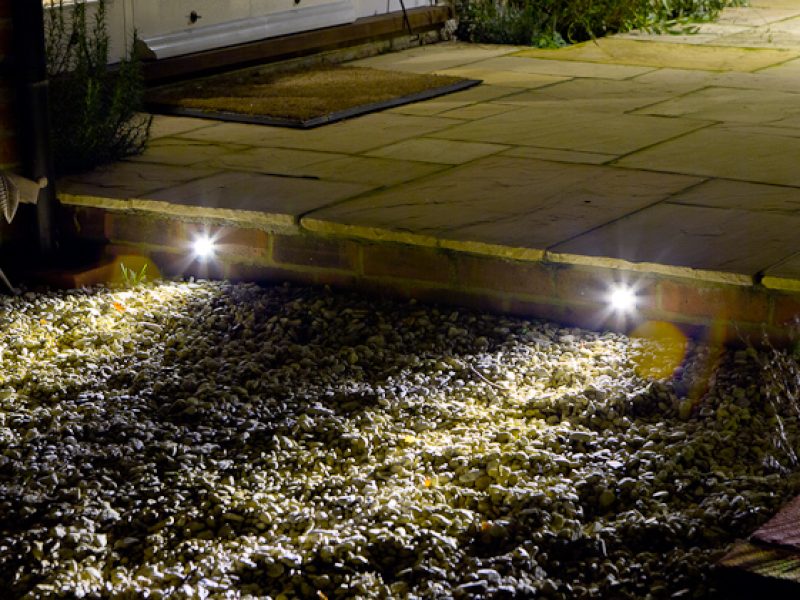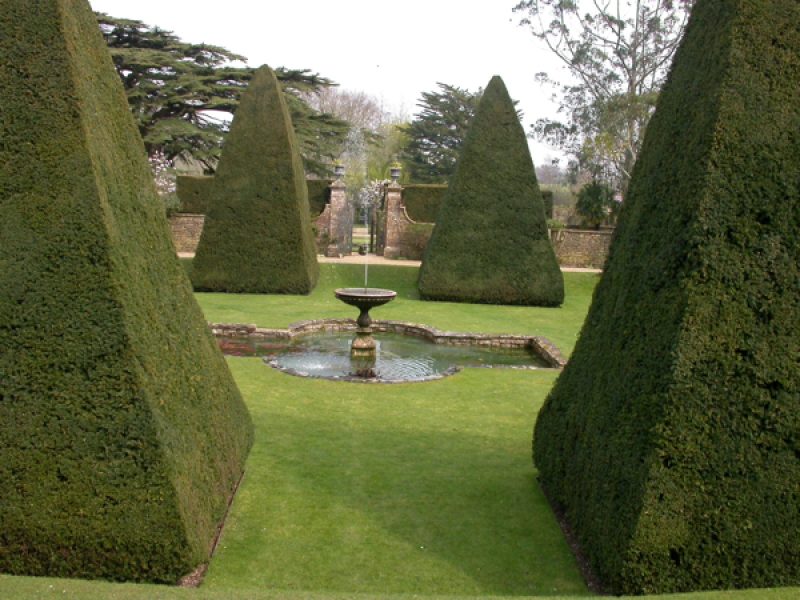I have a number of garden design plans which are nearing completion at the moment and we’re getting to the tricky subject of paving choices. It really is one of the hardest decisions to make in the design and build of a new garden as there are so many factors to take into consideration, and it needs serious thought as the costs involved can be substantial. And unfortunately the choice isn’t getting easier as every year the major paving suppliers come up with new products to add to the mix! So if you’re bemused and bewildered by the choices on offer, here’s a simple checklist of things to consider before you decide what materials you choose:
What’s your style?
Is your house traditional or contemporary in style? Do you want your paving material to fit the style of the house or are you happy to contrast old and new?
If your house is very traditional and built in brick or stone, the obvious choice for paving is to go with brick and the same local stone or an all rounder such as Yorkstone which seems to work in pretty much any situation. If you’ve got a very contemporary house you may prefer something with a cleaner sharper look, maybe slate or granite, or a sawn sandstone.
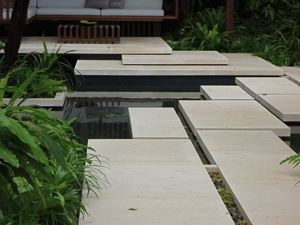
But you don’t have to be a slave to tradition and just do what’s expected, in fact modern materials can look fantastic next to traditional buildings and vice versa, but it’s something that needs to be thought out carefully. (And if you’re thinking long term – possibly about selling your house in the not-too-distant future – I’d advise you not to get too wacky in your choices. You could put potential buyers off).
Think about colour and its effect
Are you paving in a bright sunny part of the garden or is shade an issue? Think about colours of the stone you are choosing, not only to get the right tones to complement any nearby buildings and existing hard landscaping, but also in terms of the effect the stone will have on making a space brighter or not. A lighter coloured stone can really lift a gloomy space but with that choice comes the problem of keeping the stone clean. You could consider sealing light-coloured paving to reduce the chance of staining (this can be done in advance by stone merchants, but there is of course an additional cost involved).
Are you concerned about where your stone is coming from?
You may also like to check that your supplier is sourcing their stone ethically – some of the stone currently on the market is unbelievably cheap, and certainly in the past concerns have been raised about the safety of some of the overseas quarries supplying stone. You may be aware that Indian Sandstone has become hugely popular in the UK over the last 10 or so years – and that popularity is based largely on price. Despite the fact it’s travelled so far to get to the UK, much of it is now cheaper than local stone or precast slabs. There’s no denying it can be a very good cost-effective alternative for the more expensive stones such as Yorkstone, however it can vary hugely in quality and also in colour (a real case of you get what you pay for).
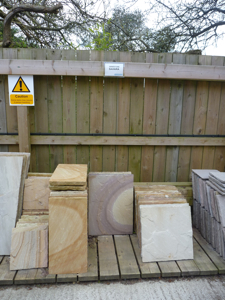
And be aware that within one colour range you could be supplied with stone with tones of pink, beige, orange, grey …. I always advise my clients if at all possible to go to a stone merchants where you can see the paving laid out en masse to get a clear idea of the colours and textures you are likely to end up with. It doesn’t always look like it does in the brochure! And look at it in dry and wet weather to get the full picture.
What about your budget?
Budget is often the deciding factor when it comes down to it, but it’s aso important to take into account the cost of laying the stone you choose. Many natural stones are supplied in varying thicknesses, and it’s a lot harder and more time-consuming for a landscaper to lay an area of paving if all the stones are of different thicknesses. Reclaimed Yorkstone in particular can be a nightmare as it can vary massively in this regard. It also weighs a ton which makes laying it a very slow and costly process.
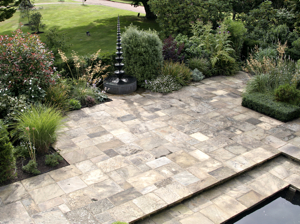
You can pay a higher price to buy new stone that has been cut to a uniform thickness, or you could consider using pre-cast or reconstituted slabs. Some of the ‘fake’ products on offer these days really are pretty impressive in terms of mimicking natural stone, and they can be a better solution if for example you like the look of sandstone but don’t like the wild colour variations.
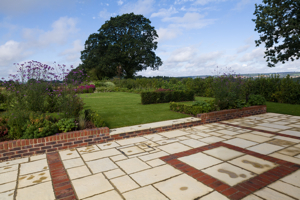
Of course there are many other very attractive natural stones to choose from apart from sandstone – limestone, quartzite, granite, slate, Purbeck stone and Travertine to name a few. The key is to do your homework and make sure you know where the stone originates from and (very importantly in the UK) that it can cope with freezing weather.
Where is the paving being used?
If it’s being laid in an area that gets little sun and it will be covered in algae by the end of winter that’s okay if you don’t need to walk on it. But for pedestrian areas you don’t want stone underfoot that will be really slippery and slimey when it gets wet (and the same goes for decking which can be lethal when wet). You also need to think about the surface finish of the stone you choose – a riven finish is great for a traditional look, but this uneven surface on sandstone and Yorkstone can be seriously dangerous when wet – as can a very smooth surface.
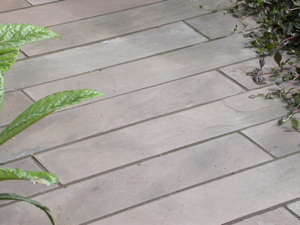
Consider opting for stone with a shotsawn, bush hammered or tooled finish on the surface which would solve the problem (you can specify this by getting the stone directly from a quarry). In recent years we’ve seen Porcelain tiles being introduced to the landscaping market. It’s great for a clean crisp look and is marketed as being easy to clean and slip-resistant.
Jetwashing will get rid of the algae and do a lot to keep paving clean but it can also damage mortar joints, so you could consider laying paving with clean edges which can be ‘butt-jointed’ (ie no mortar joints between the slabs).
A cost effective alternative to stone slabs is loose stone (gravel, shingle, chippings etc.). If you want to use a space for outdoor dining for example, gravel is best avoided where you will be putting your furniture as it will be difficult to move the chairs easily. And do avoid laying gravel right next to the lawn (always use a mowing edge like a strip of brickwork) or you could have stones flying through your windows next time you cut the grass!
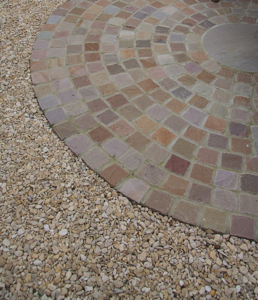
Also choose a stone of a reasonable size that won’t be carried in to the house on your shoes, or kicked about all over the garden (or used as a toilet by next door’s cat!). Avoid the big stones (reminiscent of Brighton Beach) as they are a nightmare to walk on, and ideally go for flatter stones for any pedestrian areas, as they move less and create an easy surface to walk on and use wheelbarrows etc.
What about drainage?
One big advantage of choosing gravel surfacing is that you won’t need to worry about rainwater draining away as you might with a large surface area of paving. And this could be something to bear in mind particularly if you are planning to create or increase the size of a driveway in your front garden. It is now a requirement to gain planning permission for any new area of impermeable driveway over 5 square metres in size (unless it drains to a permeable area), so if you don’t want to use block pavers or porous asphalt, gravel would be a good option.
There are 3 major stone companies who supply stone merchants nationally in the UK, so if you don’t have a local quarry who can supply what you want, it’s worth taking a look at their websites to get a feel for the variety of paving products available. Check out Marshalls, Bradstone and Stonemarket.
You’ll soon realise that paving is a big subject (and I haven’t even mentioned alternatives to stone such as bricks, setts, cobbles, block pavers, sealed gravels, timber….) and it may not be the most exciting subject in the world (!), but if you’re planning some new hard landscaping in your garden it’s important to spend some time thinking really hard about what you are looking to achieve. If you don’t, you could risk making an expensive mistake by choosing materials which are completely unsuitable for your needs.


